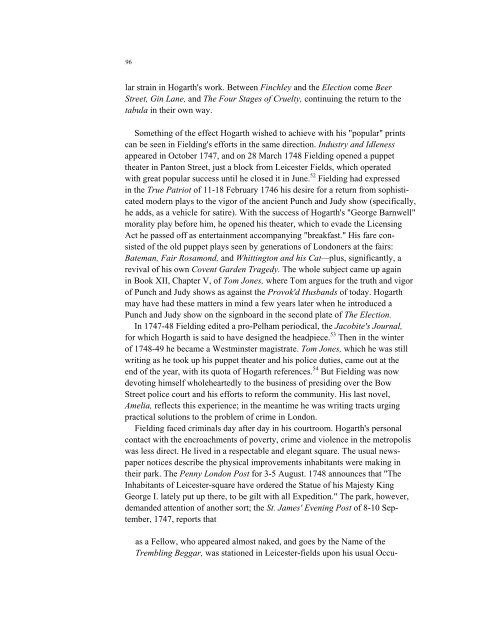Create successful ePaper yourself
Turn your PDF publications into a flip-book with our unique Google optimized e-Paper software.
96<br />
lar strain in <strong>Hogarth</strong>'s work. Between Finchley <strong>and</strong> the Election come Beer<br />
Street, Gin Lane, <strong>and</strong> The Four Stages of Cruelty, continuing the return to the<br />
tabula in their own way.<br />
Something of the effect <strong>Hogarth</strong> wished to achieve with his "popular" prints<br />
can be seen in Fielding's efforts in the same direction. Industry <strong>and</strong> Idleness<br />
appeared in October 1747, <strong>and</strong> on 28 March 1748 Fielding opened a puppet<br />
theater in Panton Street, just a block from Leicester Fields, which operated<br />
with great popular success until he closed it in June. 52 Fielding had expressed<br />
in the True Patriot of 11-18 February 1746 his desire for a return from sophisti-<br />
cated modern plays to the vigor of the ancient Punch <strong>and</strong> Judy show (specifically,<br />
he adds, as a vehicle for satire). With the success of <strong>Hogarth</strong>'s "George Barnwell"<br />
morality play before him, he opened his theater, which to evade the Licensing<br />
Act he passed off as entertainment accompanying "breakfast." <strong>His</strong> fare con-<br />
sisted of the old puppet plays seen by generations of Londoners at the fairs:<br />
Bateman, Fair Rosamond, <strong>and</strong> Whittington <strong>and</strong> his Cat—plus, significantly, a<br />
revival of his own Covent Garden Tragedy. The whole subject came up again<br />
in Book XII, Chapter V, of Tom Jones, where Tom argues for the truth <strong>and</strong> vigor<br />
of Punch <strong>and</strong> Judy shows as against the Provok'd Husb<strong>and</strong>s of today. <strong>Hogarth</strong><br />
may have had these matters in mind a few years later when he introduced a<br />
Punch <strong>and</strong> Judy show on the signboard in the second plate of The Election.<br />
In 1747-48 Fielding edited a pro-Pelham periodical, the Jacobite's Journal,<br />
for which <strong>Hogarth</strong> is said to have designed the headpiece. 53 Then in the winter<br />
of 1748-49 he became a Westminster magistrate. Tom Jones, which he was still<br />
writing as he took up his puppet theater <strong>and</strong> his police duties, came out at the<br />
end of the year, with its quota of <strong>Hogarth</strong> references. 54 But Fielding was now<br />
devoting himself wholeheartedly to the business of presiding over the Bow<br />
Street police court <strong>and</strong> his efforts to reform the community. <strong>His</strong> last novel,<br />
Amelia, reflects this experience; in the meantime he was writing tracts urging<br />
practical solutions to the problem of crime in London.<br />
Fielding faced criminals day after day in his courtroom. <strong>Hogarth</strong>'s personal<br />
contact with the encroachments of poverty, crime <strong>and</strong> violence in the metropolis<br />
was less direct. He lived in a respectable <strong>and</strong> elegant square. The usual news-<br />
paper notices describe the physical improvements inhabitants were making in<br />
their park. The Penny London Post for 3-5 August. 1748 announces that "The<br />
Inhabitants of Leicester-square have ordered the Statue of his Majesty King<br />
George I. lately put up there, to be gilt with all Expedition." The park, however,<br />
dem<strong>and</strong>ed attention of another sort; the St. James' Evening Post of 8-10 Sep-<br />
tember, 1747, reports that<br />
as a Fellow, who appeared almost naked, <strong>and</strong> goes by the Name of the<br />
Trembling Beggar, was stationed in Leicester-fields upon his usual Occu-
















